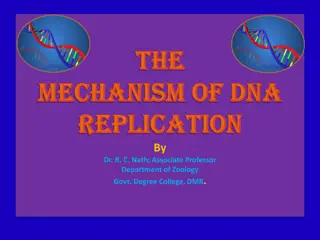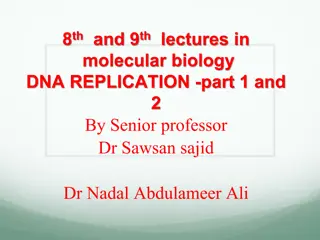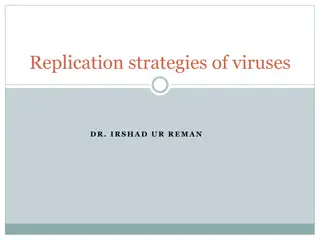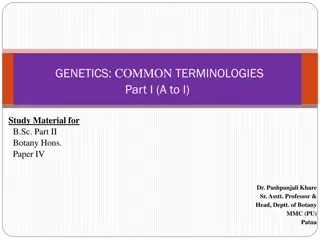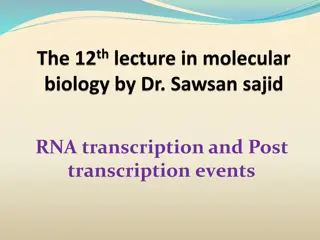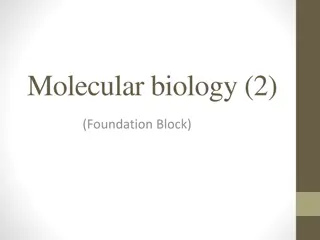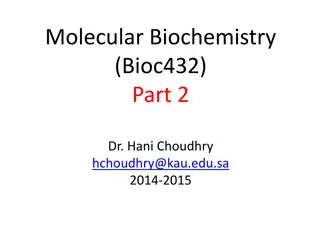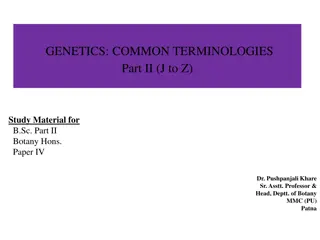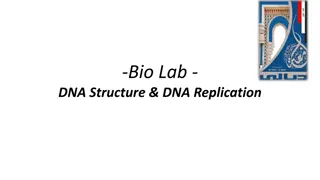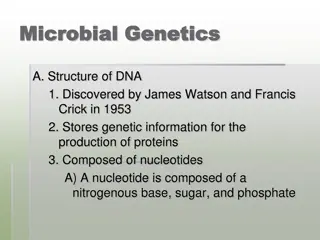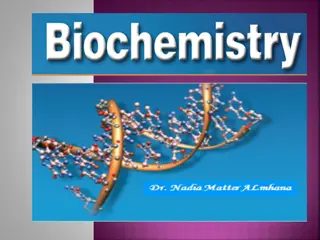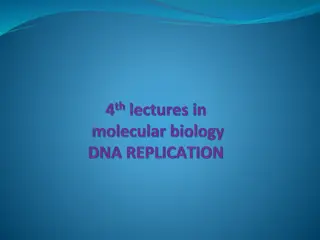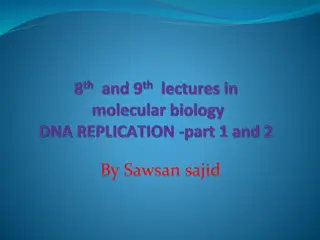Understanding DNA Replication in Prokaryotes for B.Sc. Botany Hons. Students
Study material on DNA replication in prokaryotes focusing on key concepts like semiconservative mode of replication, involvement of enzymes, different models for understanding replication, and the bidirectional nature of DNA replication in prokaryotes. The material covers the process steps including initiation, elongation, and termination, with detailed explanations on the functions of enzymes like DNA pol I and pol II. Structural aspects of DNA pol III are also discussed, along with the detailed steps involved in DNA replication, from origin recognition to termination.
Download Presentation

Please find below an Image/Link to download the presentation.
The content on the website is provided AS IS for your information and personal use only. It may not be sold, licensed, or shared on other websites without obtaining consent from the author. Download presentation by click this link. If you encounter any issues during the download, it is possible that the publisher has removed the file from their server.
E N D
Presentation Transcript
DNA-REPLICATION IN PROKARYOTES Study Material for B.Sc. Part II Botany Hons. Paper IV Dr. Pushpanjali Khare Sr. Asstt. Professor & Head, Deptt. of Botany MMC (PU) Patna
INTRODUCTION Replication is an Autocatalytic function of DNA This has been studied in detail by Messelson and Stahl The mode of replication in DNA is SEMICONSERVATIVE There are various factors involved in the replication of DNA, among which ENZYMES play a major role DNA replication takes place in Prokaryotes as well as Eukaryotes Different models of DNA replication has been given to understand the process of Replication in Prokaryotes and Eukaryotes separately The replication takes place in several steps: Initiation, Elongation and Termination In Prokaryotes replication of DNA is bidirectional
FUNCTION OF DNA pol I: EXONUCLEASE ACTIVITY Break down of polynucleotide sequence
STRUCTURE OF DNA pol III DNA pol III
STEPS OF DNA-REPLICATION RCCOGNITION OF ORIGIN (Ori-site) OPENING OF DNA TO GENERATE REGION OF ssDNA CAPTURE OF HELICASE ENZYME (5 ---> 3 ) INITIATION FORMATION OF REPLICATION FORK PRESENCE AND USE OF SEVERAL ENZYMES CONVERSION OF OKAZAKI FRAGMENTS INTO CONTINUOUS STRAND FORMATION OF MULTIPLE PRIMERS ON LEADING AND LAGGING STRANDS DNA POLYMERASE ASSEMBLY REMAINS PROCESSIVE ELONGATION TAKES PLACE AT TERMINUS REGION (Ter-site) TWO REPLICATION FORK MEETS AT ONE POINT BINDING OF TERMINATING PROTEIN(enzyme) ELONGATION STOPS TERMINATION
INITIATION DNA replication begins from origin. In E coli, replication origin is called Ori C which consists of 245 base pair and contains DNA sequences that are highly conserved among bacterial replication origin. Two types of conserved sequences are found at Ori C, three repeats of 13 bp (GATRCTNTTNTTTT) and four/five repeats of 9 bp (TTATCCACA) called 13 mer and 9 mer respectively.
PRE-PRIMING COMPLEX Dna A is replication initiation protein /factor in prokaryotes Dna C loading factor for helicase B
The complexicity lies in the co-ordination of leading and lagging strand synthesis. Both the strand are synthesized by a single DNA polymerase III dimer which accomplished the looping of template DNA of lagging strand synthesizing Okazaki fragments. Helicase (DNA B) and primase (DNA C) constitute a functional unit within replication complex called primosome complex DNA pol III use one set of core sub unit (Core polymerase) to synthesize leading strand and other set of core sub unit to synthesize lagging strand. In elongation steps, helicase in front of primase and pol III, unwind the DNA at the replication fork and travel along lagging strand template along 5 -3 direction so that replication can continue Lagging strand synthesis is not complete until the RNA primer has been removed and the gap between adjacent Okazaki fragments are sealed The RNA primer are removed by exonuclease activity (5 -3 ) of DNA pol-I and replaced by DNA The gap is then sealed by DNA ligase using NAD as co-factor
Both leading and lagging strand are synthesized co-ordinately and simultaneously by a complex protein moving in 5 -3 direction. In this way both leading and lagging strand can be replicated at same time by a complex protein that move in same direction. Every so often the lagging strands must dissociate from the replicosome and reposition itself
MECHANISM OF SYNTHESIS i. Leading strand synthesis: Leading strand synthesis is more a straight forward process which begins with the synthesis of RNA primer by primase at replication origin. DNA polymerase III then adds the nucleotides at 3 end. The leading strand synthesis then proceed continuously keeping pace with unwinding of replication fork until it encounter the termination sequences (ter) ii. Lagging strand synthesis: The lagging strand synthesized in short fragments called Okazaki fragments. At first RNA primer is synthesized by primase and as in leading strand DNA polymerase III binds to RNA primer and adds Dntps.
TERMINATION Eventually the two replication fork of circular E. coli chromosome meet at termination recognizing sequences (ter) The Ter sequence of 23 bp are arranged on the chromosome to create trap that the replication fork can enter but cannot leave. Ter-sequences function as binding site for TUS protein Ter-TUS complex can arrest the replication fork from only one direction. Ter-TUS complex encounter first with either of the replication fork and halt it. The other opposing replication fork halted when it collide with the first one. This seems the Ter-TUS sequences is not essential for termination but it may prevents over replication by one fork if other is delayed or halted by a damage or some obstacle When either of the fork encounter Ter-TUS complex, replication halted Final few hundred bases of DNA between these large protein complexes are replicated by not yet known mechanism forming two interlinked (cataneted) chromosome In E. coli DNA topoisomerase IV (type II) cut the two strand of one circular DNA and segrate each of the circular DNA and finally join the strand. The DNA finally transfer to two daughter cell
ROLLING-CIRCLE MODE OF REPLICATION IN PROKARYOTES Bacterial plasmids (Unique Characteristics of Prokaryotic Cells) replicate by a process similar to that used to copy the bacterial chromosome, other plasmids, several bacteriophages, and some viruses of eukaryotes use rolling circle mode of replication The circular nature of plasmids and the circularization of some viral genomes on infection make this possible Rolling circle replication begins with the enzymatic nicking of one strand of the double-stranded circular molecule at the double-stranded origin (dso) site In bacteria, DNA polymerase III binds to the 3 -OH group of the nicked strand and begins to replicate unidirectionaly, using the un-nicked strand as a template, displacing the nicked strand as it does so Completion of DNA replication at the site of the original nick results in full displacement of the nicked strand, which may then recircularize into a single- stranded DNA molecule RNA primase then synthesizes a primer to initiate DNA replication at the single- stranded origin (sso) site of the single-stranded DNA (ssDNA) molecule, resulting in a double-stranded DNA (dsDNA) molecule identical to the other circular DNA molecule
Diagram: Showing Rolling circle mode of DNA replication in Prokaryotes
DNA- REPLICATION IN PROKARYOTES Students are requested to share their queries on Whatsapp group: MMC Botany (D2) OR khare.pushpanjali2@gmail.com OR # 9708063491


